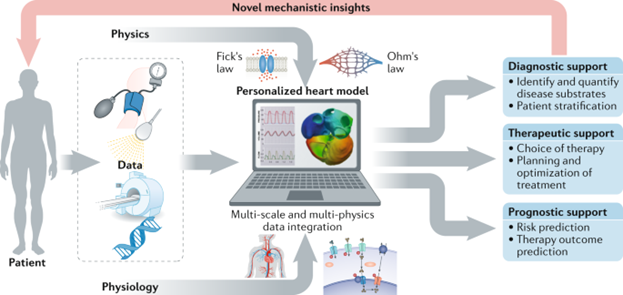Computational approaches for the preparation of medicine are a recent growing impact on scientific research. With the emergence of increasing computing power, new computer algorithms, and rising levels of clinical data, it can now predict increasingly complex outcomes for patients. It is a growing trend in the development of statistical tools to identify genetic associations of various diseases and robustly linking each one with a specific gene, cell type, stimulatory condition, and ultimately to a biological pathway. Science answers Computational biology as “How to learn and use models of biological systems derived from experimental measurements?” These models describe what and how biological tasks are carried out by particular nucleic acid or peptide sequences, and the genes, when expressed, produce a particular phenotype or behavior, type of sequence change in gene or protein expression or localization lead to a particular disease, and how changes in cell organization influence cell behavior.
Due to the inherent complexity of coupled nonlinear biological systems, the development of the computational model is essential for achieving a quantitative understanding of the structure and function in health and disease. Statistical learning is applied in high-dimensional biomolecular data and to create models that describe associations between molecules and networks. Multiscale modeling links networks to the cells, organs, and organ systems. Computational approaches are utilized to characterize anatomic shape and variations in disease and health. By incorporating health informatics, mathematics, bench science, statistics, and social sciences into classical and molecular epidemiology, disease transmission is better understood at all levels. This extends from individuals to the environment in which we live, providing us with opportunities to profile health-related settings, predict healthcare risks, and establish innovative and effective health solutions. It uses computers to better understand, diagnose, and treat human disease.
Computational Models to Medicine
The rapid increase of computational power in recent time has enabled the emergence of new experimental field: computational (in silico) modelling. From surgery to drug design, the numerical models are not only utilized to describe physiological phenomena, but also to derive useful information and drive clinical decisions. Computational biology is involved in the development and application of analytical-data and theoretical methods, computational simulation techniques, and mathematical modeling to the study of biological, behavioral, ecological, and social systems. There is a growing recognition that the tabulation of the molecular building blocks from which biological systems are composed is insufficient to understand the systems' functional properties in health and disease. This inherent complexity necessitates the development of models to achieve a quantitative understanding of the structure and function of the living systems. Computational modeling is also applied to understand the unexplained structure and function of living systems in disease, and insights gained from modeling can be used to develop improved disease diagnosis and treatment methods. Scientists refer to the growing approach as “computational medicine.” This includes the models of molecular networks and physiological processes and modeling anatomic shapes layered with physiological function. Although modeling approaches used in each area of computational medicine differ, the common thread is the use of quantitative models to understand the altered structure and function in disease.
Physiological Computational Medicine
The goal of physiological computational medicine is to develop mechanistic models of biological systems in disease and how system properties may change over time, and then translate insights gained from the models to improved therapies.

Applications of Modeling Physiological Function in Disease
Cancer: There is a large body of work on computational modeling of cancer processes and mathematical methods for detection. The ability of the model is to predict the volume of the tissue that will help guide surgeons during the procedure and may reduce the need for repeat resections.
Diabetes: A subcutaneous continuous glucose-monitoring sensor is coupled with an insulin infusion pump, and a control algorithm is used to adjust insulin delivery as a function of measured glucose level. A challenge in developing these systems is devising the appropriate strategy for controlling insulin delivery.
Conclusion
The development of information-gathering technologies such as high-throughput technology in proteomics and genomics, and the introduction of related techniques for managing large-scale data, have facilitated a dramatic increase in the degree of quantification applied to modern biological research. Computational modeling and analysis will play a critical role in deciphering meaningful systems from large sets of noisy and incomplete data and understanding the biological systems.

